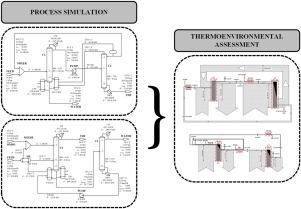Chemical Engineering and Processing: Process Intensification ( IF 4.3 ) Pub Date : 2019-11-19 , DOI: 10.1016/j.cep.2019.107748 Patrick V. Mangili , Mônica P. Maia

|
There are different purification technologies aimed at separating azeotropic mixtures, among which extractive and pressure-swing distillation stand out. While the former is characterized by the use of a solvent, the latter is employed when the composition of mixtures is significantly affected by the operating pressure. In this article, said separation technologies are applied to a tetrahydrofuran-water mixture and further compared to one another in terms of their exergetic performance and CO2 emission rate. Two configurations were used as case studies and further improved in order to propose new fully-integrated designs. The exergy analysis was performed by determining both the total exergy destruction rate and exergetic efficiency, whereas the CO2 emissions were evaluated by estimating the indirect releases due to electricity and thermal energy consumption. Although the results showed that the proposed schemes have a higher exergetic performance and lower CO2 emission rate than their original designs, the extractive processes proved to be better than both pressure-swing technologies. More specifically, the proposed fully heat-integrated extractive configuration was deemed to be the best alternative since it has approximately 7.4 % lower exergy destruction rate and 7.2 % lower carbon emission rate than the fully heat-integrated pressure-swing scheme.
中文翻译:

四氢呋喃-水分离过程的能效表现和CO 2排放的比较
有多种分离共沸混合物的纯化技术,其中萃取法和变压蒸馏法尤为突出。前者的特点是使用溶剂,而当混合物的组成受操作压力的影响很大时,可以使用后者。在本文中,将所述分离技术应用于四氢呋喃-水混合物,并在其高能性能和CO 2排放速率方面进行了进一步比较。使用了两种配置作为案例研究,并进行了进一步改进,以提出新的完全集成的设计。通过确定总的火用破坏率和火用效率来进行火用分析,而CO 2通过估算由电力和热能消耗引起的间接排放来评估排放。尽管结果表明,所提出的方案比其原始设计具有更高的火力性能和更低的CO 2排放率,但事实证明,萃取过程优于两种变压技术。更具体地,所提出的完全热集成的抽气构造被认为是最佳的替代方案,因为与完全热集成的压力波动方案相比,它的火用破坏率降低了约7.4%,碳排放率降低了7.2%。

























 京公网安备 11010802027423号
京公网安备 11010802027423号